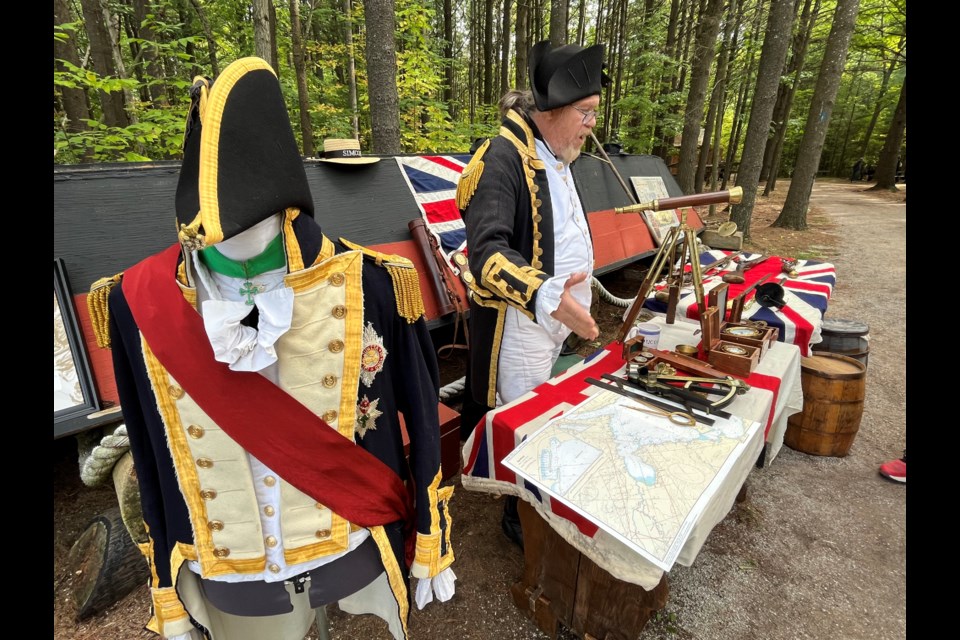The following was submitted on behalf of Chris Parker from the Nottawasaga Valley Conservation Authority (NVCA), with contributions from Trevor Carter, a licensed archaeologist with the Ministry of Tourism, Culture and Sport, and chair of social studies at St. Joseph's Catholic High School in Barrie.
Trevor Carter is a high school teacher at St. Joseph’s Catholic High School in Barrie and a licensed archaeologist.
Since 2005, his Grade 12 archaeology and Canadian history students spend six weeks excavating at Fort Willow Conservation Area, just west of Barrie in Springwater Township, digging up remnants of the past and putting the pieces together to create a better understanding of the history of our area.
During their 2023 dig, Carter and his class unearthed fragments from a children’s plate with blue printed text, which aligned with lines from an 1812 book called My Sister, by Mary Benson.
While the plate could have arrived with any number of families that squatted at the site after it was abandoned, printed ceramics like this plate were more often found in wealthier homes, like those of officers.
Archaeological evidence of children at Fort Willow is rare, making this plate fragment an intriguing find. This discovery is made more interesting by its potential link to one of the most enduring mysteries of the site.
On Aug. 6, 1825, Lance Cpl. Owen Keirne walked into the woods near the “Nottawasaga Storehouses,” now known as Fort Willow, and was never seen again.
He left behind four daughters, one of which he never met, and his wife, Bridgit Keirne.
Owen Keirne was officially discharged from duty on Sept. 6, 1825, after a month-long search failed to find him. Keirne had been stationed at the rundown depot since June 1, 1824.
Bridget and her four daughters were discharged from the care of the naval base at Penetanguishene; the search continues for any further records about their fate after leaving Penetanguishene.
This is the story as told by the Muster Book from the Naval Base at Penetanguishene.
The circumstances around Keirne’s disappearance are mysterious and made all the harder to piece together by time and its effects on people’s memory.
In 1890, 65 years after the fact, an aging Rev. Thomas Williams recalled a very similar story from his childhood, but his version features a Cpl. James Cannon, who may or may not have made significant sums of money selling alcohol.
According to the reverend, Cannon’s wife had left to give birth at Penetanguishene, so a man named Lawrence was on his way to keep the corporal and his three children company.
On his way, the man heard gunshots in the woods, but thought nothing of them at the time. When Lawrence arrived, however, he found the children alone with no sign of the corporal.
After spending the night with the girls without their father’s return, the naval base at Penetanguishene was alerted and a search of the forest was made.
According to the reverend, who was just 14 at the time of the disappearance, speculation of whether the corporal deserted or was killed for the money from his alcohol sales made the rounds.
Muster rolls from the period fail to list any corporals named James Cannon, but the details of Rev. Williams’s story do align with the documentation of Owen Keirne’s disappearance from that same timeframe.
There is no indication that Keirne had a license to sell alcohol, however. These discrepancies in memory and documented events make putting the stories of the past together challenging for people who wish to preserve them.
The plate fragment uncovered by Carter’s class provides compelling material support for a family living at Fort Willow around the time of the disappearance.
Considering the corporal’s family had three — soon to be four — daughters, it is deeply symbolic that the blue printed text on the child’s plate fragment was taken from an 1812 children’s book about the kindness of sisters.
To learn more about Fort Willow and experience what life was like in the early 1800s, join NVCA at the Festival at Fort Willow on Friday, Oct. 4 and Saturday, Oct. 5.



